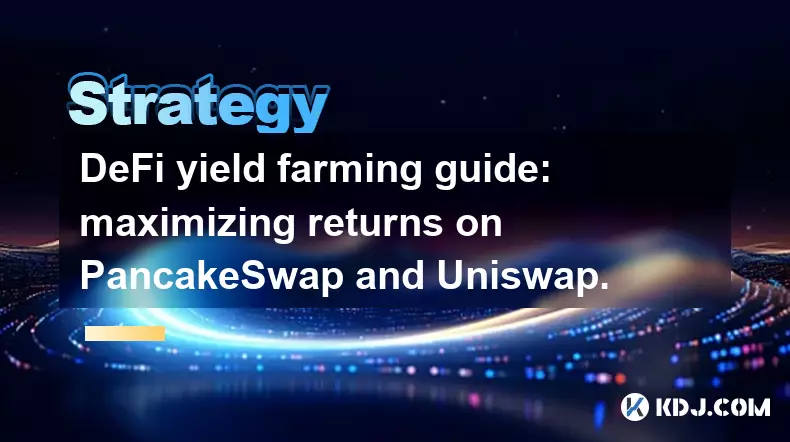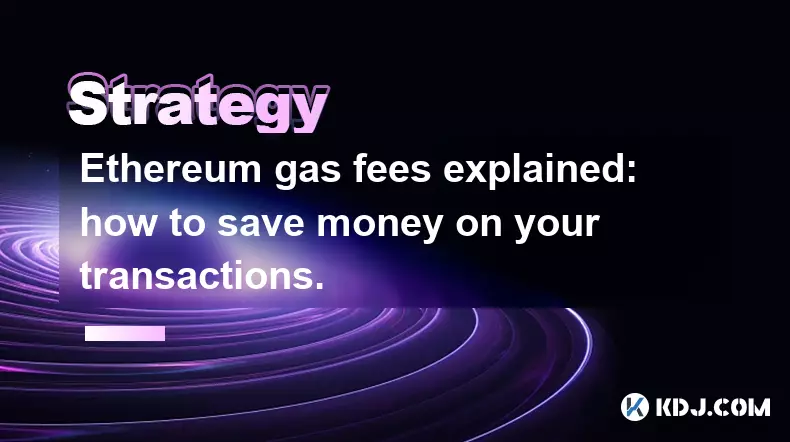-
 bitcoin
bitcoin $100977.009184 USD
-2.05% -
 ethereum
ethereum $3282.009150 USD
-3.23% -
 tether
tether $0.999813 USD
-0.02% -
 xrp
xrp $2.208254 USD
-4.89% -
 bnb
bnb $951.411089 USD
0.55% -
 solana
solana $155.761205 USD
-2.84% -
 usd-coin
usd-coin $1.000217 USD
0.02% -
 tron
tron $0.284475 USD
-1.28% -
 dogecoin
dogecoin $0.162363 USD
-1.53% -
 cardano
cardano $0.533988 USD
-0.47% -
 hyperliquid
hyperliquid $39.174339 USD
-3.22% -
 chainlink
chainlink $14.724828 USD
-1.16% -
 bitcoin-cash
bitcoin-cash $477.297986 USD
-1.28% -
 zcash
zcash $554.227426 USD
17.30% -
 ethena-usde
ethena-usde $0.998995 USD
-0.03%
DeFi yield farming guide: maximizing returns on PancakeSwap and Uniswap.
Yield farming on PancakeSwap and Uniswap lets users earn rewards by providing liquidity, with key differences in fees, yields, and risks tied to their respective blockchains.
Nov 05, 2025 at 12:20 am

Understanding Yield Farming on PancakeSwap and Uniswap
1. Yield farming has become a central activity in the decentralized finance (DeFi) space, allowing users to earn rewards by providing liquidity to decentralized exchanges. PancakeSwap, built on Binance Smart Chain, and Uniswap, operating on Ethereum, are two of the most prominent platforms enabling this practice. Users deposit pairs of tokens into liquidity pools, which facilitate trading, and in return, they receive a share of transaction fees along with additional token incentives.
2. The mechanics behind yield farming involve locking up assets in smart contracts. On Uniswap, liquidity providers receive LP (liquidity provider) tokens representing their share in a given pool. These tokens can be staked in various yield farms or lending protocols to generate further returns. PancakeSwap operates similarly but often offers higher APRs due to lower gas fees on BSC and frequent incentive programs like CAKE farming.
3. One key difference between the two platforms lies in their underlying blockchains. Ethereum’s high gas fees can make small-scale farming expensive, while Binance Smart Chain reduces costs significantly, making it more accessible for retail investors. However, Ethereum offers deeper liquidity and greater security due to its longer-standing network effects and larger developer community.
4. Choosing the right pair is crucial. Stablecoin pairs such as USDT/USDC tend to have lower impermanent loss risk but also offer lower yields. Volatile pairs like ETH/DAI may yield higher returns but expose farmers to greater price fluctuations. Traders must assess their risk tolerance before committing capital.
Strategies to Maximize Returns
1. Compounding rewards manually or through automated tools can significantly boost gains. Many farmers withdraw their reward tokens frequently and reinvest them into the same or different pools. This strategy mimics compound interest, accelerating growth over time. Some third-party dashboards now offer auto-compounding features for select pools on both Uniswap and PancakeSwap.
2. Monitoring APY changes across pools is essential for optimizing performance. Incentivized pools—those offering extra token rewards beyond trading fees—often see fluctuating yields based on governance decisions or market demand. Active farmers track these shifts using analytics platforms like DeFi Llama or CoinGecko to reallocate funds swiftly.
3. Diversifying across multiple pools reduces exposure to single-point failures. Instead of concentrating funds in one high-yield pool, spreading investments across stable and volatile pairs balances risk. It also mitigates the impact of sudden drops in APY or unexpected contract vulnerabilities.
4. Timing entries and exits around emissions schedules improves efficiency. Projects often release tokens over fixed periods; entering just after a major emission event might mean lower competition and better long-term accumulation potential. Conversely, exiting before an emission ends avoids holding low-yielding positions.
Risks and Mitigation Techniques
1. Impermanent loss remains one of the most misunderstood yet critical risks. When the price ratio of deposited tokens changes significantly from the time of deposit, LPs may end up with less value than if they had simply held the assets. This effect intensifies during high volatility. Using balanced pairs or pegged assets reduces this exposure.
2. Smart contract exploits pose a persistent threat. Both Uniswap and PancakeSwap have undergone audits, but integrations with lesser-known farms or vaults may carry unpatched vulnerabilities. Farmers should prioritize platforms with transparent code, active development teams, and insurance mechanisms where available.
3. Rug pulls and token devaluation are common in newer or anonymous projects. High-yield pools tied to obscure tokens may disappear overnight if developers abandon the project. Verifying team credibility, checking token distribution, and reviewing community engagement help identify red flags before investing.
4. Slippage and transaction costs eat into profits, especially on Ethereum. Setting appropriate slippage tolerance and batching transactions during low-network congestion periods preserves capital. Utilizing layer-2 solutions for Uniswap or staying within BSC’s low-cost environment enhances net returns.
Frequently Asked Questions
What is the difference between staking and yield farming?Staking typically involves locking a single asset to support network operations and earn rewards. Yield farming refers to providing liquidity to a trading pair in a decentralized exchange, earning fees and incentives in return. While both generate passive income, farming usually involves more complexity and risk due to impermanent loss and multi-token exposure.
Can I lose money yield farming even if prices go up?Yes. Even if overall crypto prices rise, impermanent loss can cause your portfolio value to lag behind simple holding. For example, if one token in a pair appreciates much faster than the other, the AMM rebalances the pool, leaving you with fewer units of the rising asset. Additionally, if the reward token depreciates rapidly, earnings may not offset opportunity costs.
How do I claim my farming rewards on PancakeSwap?Navigate to the “Farm” section on PancakeSwap, locate the active position, and click “Harvest” to claim accrued CAKE or other rewards. Some strategies require separately staking LP tokens in a Syrup Pool to earn additional tokens. Always confirm gas fees before executing transactions.
Are there tax implications for yield farming income?In many jurisdictions, yield farming rewards are treated as taxable income at the time of receipt. The fair market value in USD when rewards are claimed must be reported. Subsequent sales or swaps may trigger capital gains or losses. Consulting a tax professional familiar with cryptocurrency regulations ensures compliance.
Disclaimer:info@kdj.com
The information provided is not trading advice. kdj.com does not assume any responsibility for any investments made based on the information provided in this article. Cryptocurrencies are highly volatile and it is highly recommended that you invest with caution after thorough research!
If you believe that the content used on this website infringes your copyright, please contact us immediately (info@kdj.com) and we will delete it promptly.
- BlockDAG, Avalanche, Dogecoin: Crypto's Leading Trio in 2025
- 2025-11-07 22:05:01
- Layer 2 Coins: Will There Be a Potential Explosion by 2026?
- 2025-11-07 16:50:02
- Filecoin, ICP, and the AI Infrastructure Renaissance: Is History Repeating?
- 2025-11-07 16:50:02
- Bitcoin's Wild Ride: Surges, Zeros, and the Search for Stability
- 2025-11-07 17:05:01
- XRP, Bitcoin, and the Rally: What's the Deal, New York?
- 2025-11-07 17:25:01
- Filecoin, DePIN, and a Technical Breakout: What's the Buzz?
- 2025-11-07 17:05:01
Related knowledge

Navigating a crypto bear market: strategies for survival and profit.
Nov 05,2025 at 02:04pm
Navigating a Crypto Bear Market: Strategies for Survival and Profit Surviving a crypto bear market requires more than just patience—it demands strateg...

Ethereum gas fees explained: how to save money on your transactions.
Nov 04,2025 at 04:01pm
Ethereum Gas Fees: Understanding the Basics1. Ethereum operates on a decentralized network where every transaction requires computational power to exe...

Kraken margin trading explained: a complete guide to leveraging your positions.
Nov 04,2025 at 02:19pm
Kraken Margin Trading Overview1. Kraken is one of the most established cryptocurrency exchanges offering margin trading to experienced traders seeking...

NFT flipping for beginners: a step-by-step guide to profitable trading.
Nov 02,2025 at 11:54pm
NFT Flipping Basics: Understanding the Market1. NFT flipping involves purchasing non-fungible tokens at a lower price and reselling them for profit, o...

DeFi yield farming guide: maximizing returns on PancakeSwap and Uniswap.
Nov 05,2025 at 12:20am
Understanding Yield Farming on PancakeSwap and Uniswap1. Yield farming has become a central activity in the decentralized finance (DeFi) space, allowi...

How to find the next 100x altcoin: a fundamental analysis checklist.
Nov 02,2025 at 09:54pm
Decentralized Exchanges Are Reshaping Trading Dynamics1. Decentralized exchanges (DEXs) have emerged as a powerful alternative to centralized platform...

Navigating a crypto bear market: strategies for survival and profit.
Nov 05,2025 at 02:04pm
Navigating a Crypto Bear Market: Strategies for Survival and Profit Surviving a crypto bear market requires more than just patience—it demands strateg...

Ethereum gas fees explained: how to save money on your transactions.
Nov 04,2025 at 04:01pm
Ethereum Gas Fees: Understanding the Basics1. Ethereum operates on a decentralized network where every transaction requires computational power to exe...

Kraken margin trading explained: a complete guide to leveraging your positions.
Nov 04,2025 at 02:19pm
Kraken Margin Trading Overview1. Kraken is one of the most established cryptocurrency exchanges offering margin trading to experienced traders seeking...

NFT flipping for beginners: a step-by-step guide to profitable trading.
Nov 02,2025 at 11:54pm
NFT Flipping Basics: Understanding the Market1. NFT flipping involves purchasing non-fungible tokens at a lower price and reselling them for profit, o...

DeFi yield farming guide: maximizing returns on PancakeSwap and Uniswap.
Nov 05,2025 at 12:20am
Understanding Yield Farming on PancakeSwap and Uniswap1. Yield farming has become a central activity in the decentralized finance (DeFi) space, allowi...

How to find the next 100x altcoin: a fundamental analysis checklist.
Nov 02,2025 at 09:54pm
Decentralized Exchanges Are Reshaping Trading Dynamics1. Decentralized exchanges (DEXs) have emerged as a powerful alternative to centralized platform...
See all articles





















![The Graph Price Prediction [GRT Crypto Price News Today] The Graph Price Prediction [GRT Crypto Price News Today]](/uploads/2025/11/07/cryptocurrencies-news/videos/690d4df44fe69_image_500_375.webp)




















































